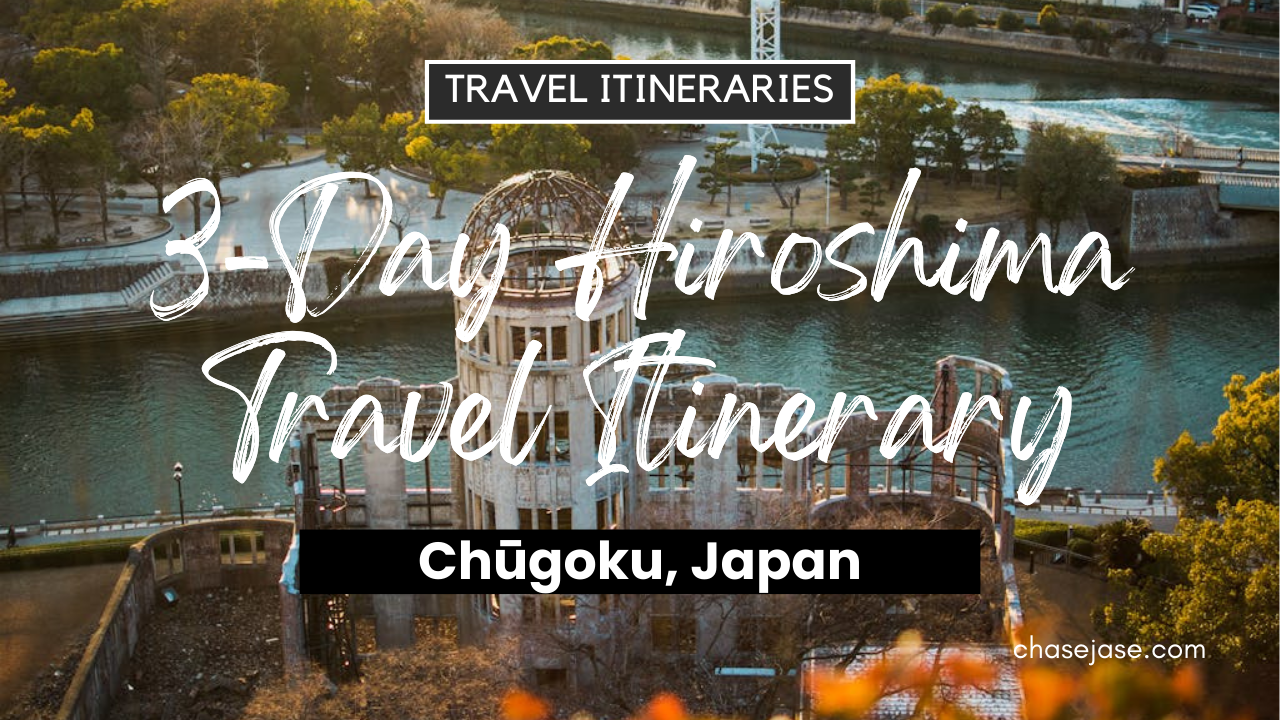3-Day Hiroshima, Japan Travel Itinerary

Introduction:
Hiroshima is a city in western Honshu, Japan, known globally for its historical significance as the first city targeted by an atomic bomb in 1945. It is now a thriving urban center that symbolizes peace and resilience. Hiroshima is important for travelers because it offers a unique blend of reflective memorials, traditional Japanese culture, delicious cuisine, and scenic natural sites. Visiting Hiroshima is a chance to experience Japan’s post-war recovery story firsthand while enjoying beautiful islands, temples, and friendly local hospitality.
Places to Visit:
- Hiroshima Peace Memorial Park: This site is dedicated to the victims of the atomic bomb and is home to monuments like the A-Bomb Dome and Peace Memorial Museum.
- Hiroshima Peace Memorial Museum: This museum offers detailed exhibits on the bombing and its aftermath, and is essential for understanding the city’s history.
- Atomic Bomb Dome (Genbaku Dome): This preserved ruin stands as a powerful symbol of the destruction and is a UNESCO World Heritage Site.
- Hiroshima Castle: A reconstructed historic castle offering a museum and views of the city from its top floor.
- Shukkei-en Garden: A beautiful traditional Japanese landscape garden designed in 1620, ideal for a peaceful stroll.
- Miyajima Island: A short ferry ride away, this island is famous for its floating torii gate and Itsukushima Shrine.
- Itsukushima Shrine: A UNESCO World Heritage Site known for its shrine buildings that appear to float on the water.
- Mount Misen: The highest peak on Miyajima Island, offering scenic hiking trails and panoramic views.
- Okonomimura: A food theme park in central Hiroshima featuring multiple restaurants serving Hiroshima-style okonomiyaki.
-
Mazda Museum: A factory tour that showcases Mazda’s history and car manufacturing process. A reservation is required.

Sample Itinerary:
Day 1: Remembering History and Local Flavors
- 9:00 AM – Hiroshima Peace Memorial Park and Museum (2 hours): Start the day learning about the city’s past. The exhibits provide a deep emotional experience.
- 11:30 AM – Atomic Bomb Dome (30 minutes): Walk outside to reflect at the iconic Genbaku Dome.
- 12:30 PM – Lunch at Okonomimura (1.5 hours): Enjoy authentic Hiroshima-style okonomiyaki from one of the many stalls.
- 2:30 PM – Shukkei-en Garden (1 hour): Relax with a peaceful stroll through this historical garden.
- 4:00 PM – Hiroshima Castle (1 hour): Visit this beautifully reconstructed castle and its museum.
- 6:00 PM – Dinner in the city center.
Day 2: Island Exploration – Miyajima Day Trip
- 8:00 AM – Depart to Miyajima Island via JR and ferry (1 hour): Take the train from Hiroshima Station to Miyajimaguchi Station, then a 10-minute ferry ride.
- 9:30 AM – Itsukushima Shrine and Floating Torii Gate (1.5 hours): Explore this iconic spiritual site that appears to float at high tide.
- 11:30 AM – Miyajima local food and shopping (1 hour): Try grilled oysters and momiji manju.
- 1:00 PM – Hike or take the ropeway to Mount Misen (2.5 hours): Experience panoramic views from the top.
- 4:00 PM – Ferry back to Hiroshima and return by 5:30 PM.

Day 3: Culture and Innovation
- 9:00 AM – Mazda Museum Tour (2 hours): See the innovation behind Japan’s famous car brand. (Requires reservation.)
- 11:30 AM – Lunch near Hiroshima Station.
- 1:00 PM – Explore local shopping streets like Hondori (2 hours): Great for souvenirs and snacks.
- 3:30 PM – Optional visit to Mitaki-dera Temple (1 hour): A serene temple in the hills, especially beautiful in autumn.
- 6:00 PM – Final dinner with views of the city.
See Itinerary Map (Includes Places to Visit and Accommodations)
Best Time To Go:
The best time to visit Hiroshima is during spring (March to May) and autumn (October to November). In spring, Hiroshima is vibrant with cherry blossoms, especially in Shukkei-en Garden and along the rivers. In autumn, the foliage turns bright red and orange, offering picturesque views at Mitaki-dera and Mount Misen. Summer can be hot and humid, while winter is mild but may limit access to hiking trails on Miyajima.
Activities To Do:
- Try Hiroshima-style Okonomiyaki: This savory pancake is a regional specialty layered with noodles and cabbage, and best enjoyed at Okonomimura.
- Take the Ropeway to Mount Misen: This scenic ride offers incredible aerial views of Miyajima and the Seto Inland Sea.
- Experience the Peace Memorial Museum: The museum gives in-depth historical context and personal stories, fostering deep reflection.
- Explore Miyajima Island: From deer roaming freely to historic shrines, the island offers a tranquil and spiritual retreat.
-
Attend a Carp Baseball Game (Seasonal): Hiroshima’s local baseball team, the Carp, play at Mazda Zoom-Zoom Stadium and offer an exciting glimpse into local sports culture.

Accommodations:
- Sheraton Grand Hiroshima Hotel: A luxury hotel directly connected to Hiroshima Station, offering spacious rooms and upscale amenities.

- RIHGA Royal Hotel Hiroshima: Centrally located near Hiroshima Castle and Peace Park, it features elegant interiors and excellent dining options.

- Hotel Granvia Hiroshima: Conveniently inside Hiroshima Station with panoramic views and comfortable rooms.

- The Knot Hiroshima: A boutique hotel with modern decor and rooftop views, close to shopping and dining.

- Guesthouse Akicafe Inn: Budget-friendly option with both dormitory and private rooms, perfect for solo travelers.

Transportation Options:
- Hiroshima Streetcar (Hiroden): The most convenient way to travel within the city, connecting all major tourist spots.
- JR Trains: Ideal for reaching Miyajima and nearby cities. The JR Pass is valid on these lines.
- Ferry Services: Regular ferries from Miyajimaguchi to Miyajima Island; JR ferry is included in the JR Pass.
- City Buses: Buses reach areas not served by streetcars, including the Mazda Museum and suburban temples.
- Meipuru~pu Tourist Bus: A hop-on-hop-off service for visitors that loops around major attractions.
- Taxi Services: Reliable and efficient for short trips, though more expensive.
-
Bicycle Rentals: Eco-friendly way to explore the city at your own pace with bike stations available throughout the city.
Tips:
- Buy a Hiroshima Streetcar Day Pass for unlimited travel, saving time and money.
- Book the Mazda Museum tour in advance through their website.
- Visit Miyajima during high tide to see the torii gate appear as if floating.
- Stay near Hiroshima Station for the easiest access to local and regional transportation.
- Pack comfortable walking shoes as most attractions require walking through spacious parks or uphill trails.
Hiroshima is more than a city marked by history—it is a vibrant, forward-looking destination that blends remembrance with revitalization. This 3-day itinerary allows visitors to absorb the powerful legacy of peace at the memorial park, taste the rich flavors of Hiroshima’s local cuisine, and explore serene landscapes like Miyajima Island. Whether you’re reflecting on the past at the Peace Museum or hiking Mount Misen’s lush trails, Hiroshima invites you to engage, explore, and be inspired. This journey through Hiroshima is both educational and uplifting, leaving you with memories that resonate deeply long after you leave.



